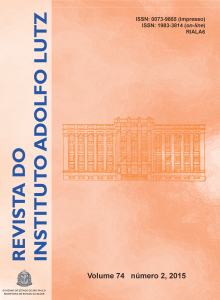Abstract
Snacks are highly consumed products due to the low price, easy and fast preparation and convenience. However, the inadequate handling and preparation of these foods increase the risk for microbiological contamination. This study aimed at examining the microbiological quality of hamburgers by performing the counts of mesophilic aerobic bacteria, total coliforms, Escherichia coli, Salmonella sp., Bacillus cereus, Staphylococcus aureus, sulfite reducer Clostridium, and molds and yeasts. Eighteen samples were collected from six lunchrooms in the city of Ouro Preto - MG. Among the analyzed samples, 56 % were classified as unsatisfactory for mesophilic aerobic counts, 67 % for total coliforms counts, 6 % for E. coli, and 61 % for molds and yeasts. Salmonella sp. was not detected in any of the analyzed samples, and the CFU/g of B. cereus, S. aureus and sulfite reducer Clostridium were under the detection limit. Despite the absence or low prevalence of the above mentioned pathogens, the high counts of mesophilic aerobic bacteria, yeasts and molds, and total coliforms indicate the need for implementing the good manufacturing practices in the evaluated establishments, and an agenda by the government to increase the supervision from the sanitary surveillance center of the municipality.
References
1. Furlaneto L, Kataoka AFA. Análise microbiológica de lanches comercializados em carrinhos de ambulantes. Lecta.2004;22(1/2):49-52.
2. Cardoso RCV, Santos SMC, Silva EO. Comida de rua e intervenção: estratégias e propostas para o mundo em desenvolvimento. Ciênc Saúde Coletiva.2009;14(4):1215-24. [DOI: 10.1590/S1413-81232009000400027].
3. Rodrigues KL, Gomes JP, Conceição RCS, Brod CS, Carvalhal JB, Aleixo JAG. Condições higiênico-sanitárias no comércio ambulante de alimentos em Pelotas-RS. Ciênc Tecnol Aliment.2003;23(3):447-52. [DOI: 10.1590/S0101-20612003000300026].
4. Lima AWO, Sousa CP. Infecções e intoxicações alimentares. In: Aspectos da Ciência e Tecnologia de Alimentos. João Pessoa: Nova Ideia; 2002. p.175-99.
5. Carmo GMI, Oliveira AA, Dimech CP, Santos DA, Almeida MG, Berto LH, et al. Vigilância epidemiológica das doenças transmitidas por alimentos no Brasil, 1999-2004. Bol Eletr Epidemiol.2005;5(6):1-7.
6. Murmann L, Santos MC, Longaray SM, Both JMC, Cardoso M. Quantification and molecular characterization of Salmonella isolated from food samples involved in salmonellosis outbreaks in Rio Grande do Sul, Brazil. Braz J Microbiol.2008;39(3):529-34. [DOI: 10.1590/S1517-838220080003000024].
7. de Novaes Oliveira M, Brasil ALD, Taddei JAAC. Avaliação das condições higiênico-sanitárias das cozinhas de creches públicas e filantrópicas. Ciênc Saúde Coletiva.2008;13(3):1051-60. [DOI:10.1590/S1413-81232008000300028].
8. Brasil. Ministério da Saúde. Resolução RDC nº 12, de 02 de janeiro de 2001. Aprova o Regulamento Técnico sobre Padrões Microbiológicos para Alimentos. Diário Oficial [da] Republica Federativa do Brasil. Brasília, DF, 10 jan. 2001.
9. Kuhn CR, Gandra EA Ferreira LR, Bartz J, Gonzáles AP, Gayer CF. Qualidade microbiológica de lanches comercializados na cidade Pelotas–RS. Gl Sci Technol.2012;5(3):1-10.
10. Brasil. Ministério da Agricultura, Pecuária e Abastecimento. Departamento de Inspeção de Produtos de Origem Animal. Instrução Normativa n° 62, de 26 de agosto de 2003. Métodos analíticos oficiais para análises microbiológicas para controle de produtos de origem animal e água. Diário Oficial [da] República Federativa do Brasil, Brasília, DF, 18 set. 2003.
11. Little CL, Gillespie IA, Mitchell RT. Microbiological examination of ready-to-eat burgers sampled anonymously at the point of sale in the United Kingdom. Commun Dis Public Health.2001;4(4):293-9.
12. Bezerra ACD, Reis RBD, Bastos DHM. Microbiological quality of hamburgers sold in the streets of Cuiabá-MT, Brazil and vendor hygiene-awareness. Ciênc Tecnol Aliment.2010;30(2):520-4. [DOI: 10.1590/S0101-20612010000200035].
13. Rodrigues PM. Bolores termorresistentes. In: Rodrigues PM. Microbiologia dos Processos Alimentares. São Paulo: Varela; 2005. p.103-19.
14. Takahashi CC, Amaral PE, Santos LCL, Contim JD, Pinto UM, Neves CVB, et al. Avaliação do treinamento de manipuladores de alimentos de restaurantes comerciais pelo ensaio ATP-bioluminescência. Rev Inst Adolfo Lutz.2013;72(4):302-8.

This work is licensed under a Creative Commons Attribution 4.0 International License.
Copyright (c) 2016 Instituto Adolfo Lutz Journal
